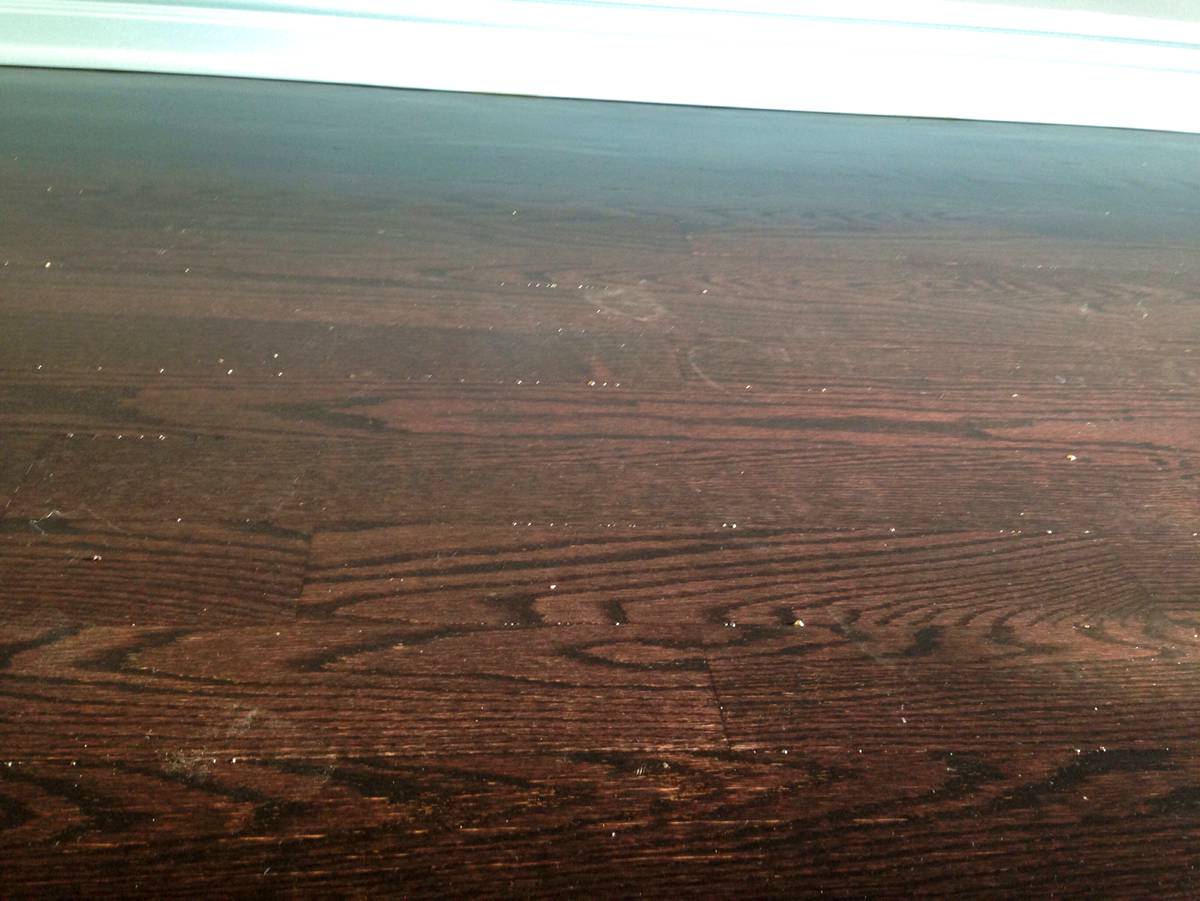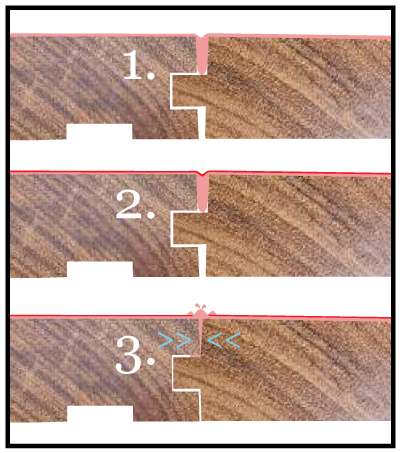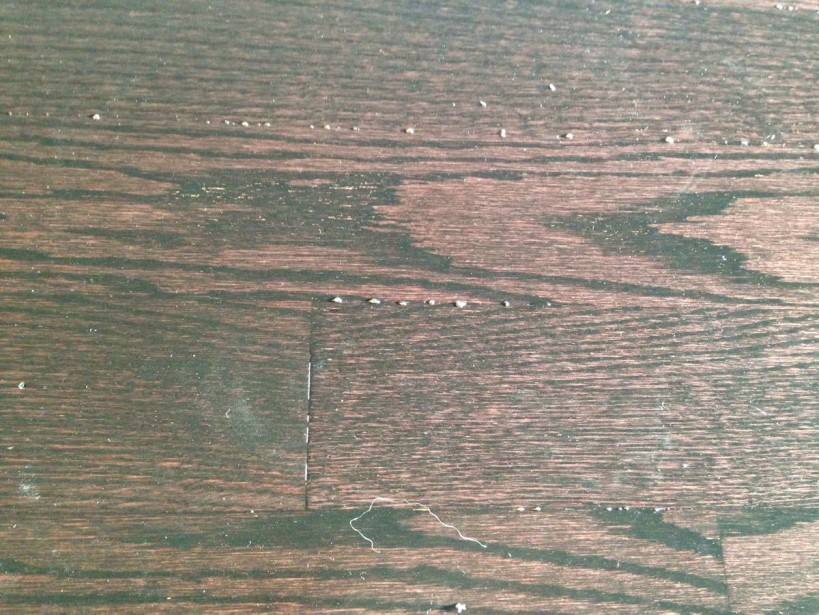Refinishing, Unfinished Flooring, wood floor gaps
Balls of Polyurethane Finish Popping Up on Your Floor
For many, summer means concerts at Millennium Park, margaritas on the deck and bubbles in the pool. When we think of summer at Mr. Floor, we think about the dozens of calls we receive from homeowners who are watching bubbles of finish pop up between the cracks of their new wood floors.
Beads of Finish Between the Cracks in My Wood Floor
The photo highlights the homeowners’ dilemma. What looks and feels like maple-syrup drops on your wood floor are actually blobs of uncured finish. Known affectionately in the industry as polyballs, or polyurethane beads, these drops of “wet” finish are pushed up to the surface from gaps between the planks of your floor. This problem normally surfaces on a floor that is less than a year old that was installed in the winter. But why?

What Causes These Polyurethane Balls to Form?
Three conditions typically conspire to form these unsightly balls of uncured finish. The first is gaps between the planks of the wood floor that allow too much newly-applied finish to pool in the cracks. The second is the subsequent application of a polyurethane finish before the first coat has had time to cure, trapping the “wet” finish. The third is when wood flooring with a very low moisture content is installed and finished, increasing the chances that expansion during the humid summer months will lead to extreme pressure between planks of wood flooring.
It will come as no surprise that if flooring is incorrectly installed with wider than normal gaps, those gaps can accumulate freshly applied finish. While more finish might seem like a good thing, when it pools between the wood slats it most definitely is not. Polyurethane finish is designed to be applied in a consistent way that allows it to flow into an even layer across the floor. If flooring is installed with gaps that are too wide, the space becomes a little trough into which the polyurethane finish accumulates. (Graphic 1)
If the pooled finish between the floor boards does not cure before a second or third coat is applied, the uncured finish is trapped in a “wet” state beneath subsequent layers. Think of it as a beautiful crème brulee. (Graphic 2, red cap) The caramelized sugar surface is hard to the touch but once you crack it, the wet custard below is released.
How Uncured Finish is Pushed to the Surface of a Wood Floor
As explained in our blog post, Wood Floor Seasoning, wood is hydroscopic. Wood both absorbs and expels moisture as the humidity in a room changes. In the winter, when there is less humidity in the air, wood slats shrink as they give off moisture.

Polyurethane bubbles most often result from improperly acclimated wood slats with a very low moisture content being installed and finished in a home during the winter when the humidity is low. Polyballs are formed when the moisture content of the wood rises, the slats expand squeezing against one another, and the uncured finish is pushed to the surface. (Graphic 3)
Another way to create favorable conditions for polyballs is to not allow sufficient time between coats of polyurethane. Like paint, a floor finish dries from the top down and when a second or third coat is applied before the first coat has cured, “wet” polyurethane can be trapped, especially in the cracks.
How Can You Prevent Polyurethane Beads From Forming?
It’s important to remember that only your wood flooring installer can prevent the appearance of polyballs. Acclimating the wood to the correct moisture content prior to installation, preparing and installing the floor properly, and following the polyurethane manufacturer’s instructions is the only way to guarantee that beads of polyurethane won’t form.
We go one step further at Mr. Floor by applying three thin coats of finish rather than two thick coats. While this does take more time and effort, the thinner coats help to eliminate any pockets of uncured polyurethane trapped beneath subsequent finish coats.
What Can I do if Polyballs Have Formed on My Floor?
If the polyurethane beads are still wet to the touch, avoid any contact with them until they have hardened. If you attempt to wipe up the semi-soft polyurethane forced to the surface, you’ll likely smear the wet coating creating a visible patch that can only be improved by sanding and recoating.
Once the polyballs have dried, it’s sometimes possible to scrape them off along the cracks using a plastic putty knife or scraper. Please remember that it is easy to scratch the “good” poly finish so work slowly and gently. If you’re lucky they will pop off and not leave a visible mark.
However, if the floor is riddled with polyurethane bubbles or you’ve smeared the beads, your installer will need to sand and refinish the entire floor. Spot refinishing almost invariably leaves a visible line where the repair has been made.
Call Mr. Floor to Learn More About Polyballs, or Polyurethane Beads
If you’ve got a floor suffering from polyballs and need a second opinion, please contact one of the flooring specialists at Mr. Floor. We’ll be glad to visit your home, assess the situation, and offer our suggestions to make your floor look better than new!
Igor Murokh
Igor is a graduate of the University of Illinois and holds a B.A. in Economics. He has worked in the flooring industry for over 30 years and is the VP and Sales Manager of Mr. Floor Companies in Skokie, IL. Igor is a certified wood flooring inspector (CWFI) and routinely helps clients assess flooring issues.

